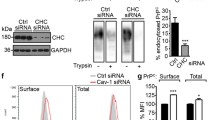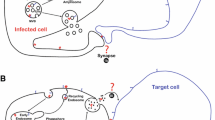Abstract
Cell-to-cell transfer of prions is a crucial step in the spreading of prion infection through infected tissue. At the cellular level, several distinct pathways including direct cell–cell contacts and release of various types of infectious extracellular vesicles have been described that may potentially lead to infection of naïve cells. The relative contribution of these pathways and whether they may vary depending on the prion strain and/or on the infected cell type are not yet known. In this study we used a single cell type (RK13) infected with three different prion strains. We showed that in each case, most of the extracellular prions resulted from active cell secretion through the exosomal pathway. Further, quantitative analysis of secreted infectivity indicated that the proportion of prions eventually secreted was dramatically dependent on the prion strain. Our data also highlight that infectious exosomes secreted from cultured cells might represent a biologically pertinent material for spiking experiments. Also discussed is the appealing possibility that abnormal PrP from different prion strains may differentially interact with the cellular machinery to promote secretion.





Similar content being viewed by others
References
Collinge J (2001) Prion diseases of humans and animals: their causes and molecular basis. Annu Rev Neurosci 24:519–550
Prusiner SB (1998) Prions. Proc Natl Acad Sci USA 95:13363–13383
Castilla J, Saa P, Hetz C, Soto C (2005) In vitro generation of infectious scrapie prions. Cell 121:195–206
Beringue V, Vilotte JL, Laude H (2008) Prion agent diversity and species barrier. Vet Res 39:47
Mabbott NA, MacPherson GG (2006) Prions and their lethal journey to the brain. Nat Rev Microbiol 4:201–211
Vilette D (2008) Cell models of prion infection. Vet Res 39:10
Kanu N, Imokawa Y, Drechsel DN, Williamson RA, Birkett CR et al (2002) Transfer of scrapie prion infectivity by cell contact in culture. Curr Biol 12:523–530
Paquet S, Langevin C, Chapuis J, Jackson GS, Laude H et al (2007) Efficient dissemination of prions through preferential transmission to nearby cells. J Gen Virol 88:706–713
Langevin C, Gousset K, Costanzo M, Richard-Le Goff O, Zurzolo C (2010) Characterization of the role of dendritic cells in prion transfer to primary neurons. Biochem J 431:189–198
Gousset K, Schiff E, Langevin C, Marijanovic Z, Caputo A et al (2009) Prions hijack tunnelling nanotubes for intercellular spread. Nat Cell Biol 11:328–336
Mattei V, Barenco MG, Tasciotti V, Garofalo T, Longo A et al (2009) Paracrine diffusion of PrP(C) and propagation of prion infectivity by plasma membrane-derived microvesicles. PLoS ONE 4:e5057
Alais S, Simoes S, Baas D, Lehmann S, Raposo G et al (2008) Mouse neuroblastoma cells release prion infectivity associated with exosomal vesicles. Biol Cell 100:603–615
Fevrier B, Vilette D, Archer F, Loew D, Faigle W et al (2004) Cells release prions in association with exosomes. Proc Natl Acad Sci U S A 101:9683–9688
Vella LJ, Sharples RA, Lawson VA, Masters CL, Cappai R et al (2007) Packaging of prions into exosomes is associated with a novel pathway of PrP processing. J Pathol 211:582–590
Bellingham SA, Guo BB, Coleman BM, Hill AF (2012) Exosomes: vehicles for the transfer of toxic proteins associated with neurodegenerative diseases? Front Physiol 3:124
Schneider A, Simons M (2013) Exosomes: vesicular carriers for intercellular communication in neurodegenerative disorders. Cell Tissue Res 352:33–47
Vingtdeux V, Sergeant N, Buee L (2012) Potential contribution of exosomes to the prion-like propagation of lesions in Alzheimer’s disease. Front Physiol 3:229
Arellano-Anaya ZE, Savistchenko J, Mathey J, Huor A, Lacroux C et al (2011) A simple, versatile and sensitive cell-based assay for prions from various species. PLoS ONE 6:e20563
Vilette D, Andreoletti O, Archer F, Madelaine MF, Vilotte JL et al (2001) Ex vivo propagation of infectious sheep scrapie agent in heterologous epithelial cells expressing ovine prion protein. Proc Natl Acad Sci USA 98:4055–4059
Courageot MP, Daude N, Nonno R, Paquet S, Di Bari MA et al (2008) A cell line infectible by prion strains from different species. J Gen Virol 89:341–347
Vilotte JL, Soulier S, Essalmani R, Stinnakre MG, Vaiman D et al (2001) Markedly increased susceptibility to natural sheep scrapie of transgenic mice expressing ovine PrP. J Virol 75:5977–5984
Le Dur A, Beringue V, Andreoletti O, Reine F, Lai TL et al (2005) A newly identified type of scrapie agent can naturally infect sheep with resistant PrP genotypes. Proc Natl Acad Sci USA 102:16031–16036
Nonno R, Di Bari MA, Cardone F, Vaccari G, Fazzi P et al (2006) Efficient transmission and characterization of Creutzfeldt–Jakob disease strains in bank voles. PLoS Pathog 2:e12
Piening N, Nonno R, Di Bari M, Walter S, Windl O et al (2006) Conversion efficiency of bank vole prion protein in vitro is determined by residues 155 and 170, but does not correlate with the high susceptibility of bank voles to sheep scrapie in vivo. J Biol Chem 281:9373–9384
Feraudet C, Morel N, Simon S, Volland H, Frobert Y et al (2005) Screening of 145 anti-PrP monoclonal antibodies for their capacity to inhibit PrPSc replication in infected cells. J Biol Chem 280:11247–11258
Thery C, Amigorena S, Raposo G, Clayton A (2006) Isolation and characterization of exosomes from cell culture supernatants and biological fluids, Curr Protoc Cell Biol, Chapter 3: Unit 3 22
van Niel G, Raposo G, Candalh C, Boussac M, Hershberg R et al (2001) Intestinal epithelial cells secrete exosome-like vesicles. Gastroenterology 121:337–349
Coleman BM, Hanssen E, Lawson VA, Hill AF (2012) Prion-infected cells regulate the release of exosomes with distinct ultrastructural features. FASEB J 26:4160–4173
Castro-Seoane R, Hummerich H, Sweeting T, Tattum MH, Linehan JM et al (2012) Plasmacytoid dendritic cells sequester high prion titres at early stages of prion infection. PLoS Pathog 8:e1002538
Leblanc P, Alais S, Porto-Carreiro I, Lehmann S, Grassi J et al (2006) Retrovirus infection strongly enhances scrapie infectivity release in cell culture. EMBO J 25:2674–2685
Booth AM, Fang Y, Fallon JK, Yang JM, Hildreth JE et al (2006) Exosomes and HIV Gag bud from endosome-like domains of the T cell plasma membrane. J Cell Biol 172:923–935
Gill ON, Spencer Y, Richard-Loendt A, Kelly C, Dabaghian R et al (2013) Prevalent abnormal prion protein in human appendixes after bovine spongiform encephalopathy epizootic: large scale survey. BMJ 347:f5675
Edgeworth JA, Farmer M, Sicilia A, Tavares P, Beck J et al (2011) Detection of prion infection in variant Creutzfeldt–Jakob disease: a blood-based assay. Lancet 377:487–493
Foster PR (2008) Selection of spiking materials for studies on the clearance of agents of transmissible spongiform encephalopathy during plasma fractionation. Biologicals 36:142–143
Kujala P, Raymond CR, Romeijn M, Godsave SF, van Kasteren SI et al (2011) Prion uptake in the gut: identification of the first uptake and replication sites. PLoS Pathog 7:e1002449
Gough KC, Maddison BC (2010) Prion transmission: prion excretion and occurrence in the environment. Prion 4:275–282
Dassanayake RP, Schneider DA, Truscott TC, Young AJ, Zhuang D et al (2011) Classical scrapie prions in ovine blood are associated with B lymphocytes and platelet-rich plasma. BMC Vet Res 7:75
Douet JY, Zafar S, Perret-Liaudet A, Lacroux C, Lugan S et al (2014) Detection of infectivity in blood of persons with variant and sporadic Creutzfeldt–Jakob disease. Emerg Infect Dis 20:114–117
Houston F, Foster JD, Chong A, Hunter N, Bostock CJ (2000) Transmission of BSE by blood transfusion in sheep. Lancet 356:999–1000
Mathiason CK, Hayes-Klug J, Hays SA, Powers J, Osborn DA et al (2010) B cells and platelets harbor prion infectivity in the blood of deer infected with chronic wasting disease. J Virol 84:5097–5107
Admyre C, Johansson SM, Qazi KR, Filen JJ, Lahesmaa R et al (2007) Exosomes with immune modulatory features are present in human breast milk. J Immunol 179:1969–1978
Caby MP, Lankar D, Vincendeau-Scherrer C, Raposo G, Bonnerot C (2005) Exosomal-like vesicles are present in human blood plasma. Int Immunol 17:879–887
Pisitkun T, Shen RF, Knepper MA (2004) Identification and proteomic profiling of exosomes in human urine. Proc Natl Acad Sci USA 101:13368–13373
Brown P, Rohwer RG, Dunstan BC, MacAuley C, Gajdusek DC et al (1998) The distribution of infectivity in blood components and plasma derivatives in experimental models of transmissible spongiform encephalopathy. Transfusion 38:810–816
Cervenakova L, Yakovleva O, McKenzie C, Kolchinsky S, McShane L et al (2003) Similar levels of infectivity in the blood of mice infected with human-derived vCJD and GSS strains of transmissible spongiform encephalopathy. Transfusion 43:1687–1694
Gregori L, McCombie N, Palmer D, Birch P, Sowemimo-Coker SO et al (2004) Effectiveness of leucoreduction for removal of infectivity of transmissible spongiform encephalopathies from blood. Lancet 364:529–531
Andreoletti O, Litaise C, Simmons H, Corbiere F, Lugan S et al (2012) Highly efficient prion transmission by blood transfusion. PLoS Pathog 8:e1002782
McCutcheon S, Alejo Blanco AR, Houston EF, de Wolf C, Tan BC et al (2011) All clinically-relevant blood components transmit prion disease following a single blood transfusion: a sheep model of vCJD. PLoS ONE 6:e23169
Vlassov AV, Magdaleno S, Setterquist R, Conrad R (2012) Exosomes: current knowledge of their composition, biological functions, and diagnostic and therapeutic potentials. Biochim Biophys Acta 1820:940–948
Bellingham SA, Coleman BM, Hill AF (2012) Small RNA deep sequencing reveals a distinct miRNA signature released in exosomes from prion-infected neuronal cells. Nucleic Acids Res 40:10937–10949
Klohn PC, Stoltze L, Flechsig E, Enari M, Weissmann C (2003) A quantitative, highly sensitive cell-based infectivity assay for mouse scrapie prions. Proc Natl Acad Sci USA 100:11666–11671
Bobrie A, Colombo M, Raposo G, Thery C (2011) Exosome secretion : molecular mechanisms and roles in immune responses. Traffic 12(12):1659–1668
Lakkaraju A, Rodriguez-Boulan E (2008) Itinerant exosomes: emerging roles in cell and tissue polarity. Trends Cell Biol 18:199–209
Futter CE, Collinson LM, Backer JM, Hopkins CR (2001) Human VPS34 is required for internal vesicle formation within multivesicular endosomes. J Cell Biol 155:1251–1264
Pan BT, Teng K, Wu C, Adam M, Johnstone RM (1985) Electron microscopic evidence for externalization of the transferrin receptor in vesicular form in sheep reticulocytes. J Cell Biol 101:942–948
Raposo G, Nijman HW, Stoorvogel W, Liejendekker R, Harding CV et al (1996) B lymphocytes secrete antigen-presenting vesicles. J Exp Med 183:1161–1172
Michelet X, Djeddi A, Legouis R (2010) Developmental and cellular functions of the ESCRT machinery in pluricellular organisms. Biol Cell 102:191–202
Stuffers S, Sem Wegner C, Stenmark H, Brech A (2009) Multivesicular endosome biogenesis in the absence of ESCRTs. Traffic 10:925–937
Theos AC, Truschel ST, Tenza D, Hurbain I, Harper DC et al (2006) A lumenal domain-dependent pathway for sorting to intralumenal vesicles of multivesicular endosomes involved in organelle morphogenesis. Dev Cell 10:343–354
Trajkovic K, Hsu C, Chiantia S, Rajendran L, Wenzel D et al (2008) Ceramide triggers budding of exosome vesicles into multivesicular endosomes. Science 319:1244–1247
van Niel G, Charrin S, Simoes S, Romao M, Rochin L et al (2011) The tetraspanin CD63 regulates ESCRT-independent and -dependent endosomal sorting during melanogenesis. Dev Cell 21:708–721
Savistchenko J, Arellano-Anaya ZE, Andreoletti O, Vilette D (2011) Mammalian prions: tracking the infectious entities. Prion 5:84–87
Arellano Anaya ZE, Savistchenko J, Massonneau V, Lacroux C, Andreoletti O et al (2011) Recovery of small infectious PrPres aggregates from prion-infected cultured cells. J Biol Chem 86:8141–8148
Laferriere F, Tixador P, Moudjou M, Chapuis J, Sibille P et al (2013) Quaternary structure of pathological prion protein as a determining factor of strain-specific prion replication dynamics. PLoS Pathog 9:e1003702
Tixador P, Herzog L, Reine F, Jaumain E, Chapuis J et al (2010) The physical relationship between infectivity and prion protein aggregates is strain-dependent. PLoS Pathog 6:e1000859
Acknowledgments
We thank Dr. V. Setola for critical reading of the manuscript. This work was partly supported by a grant from ANR-08-MIEN-010 (France) and Z. E. Arellano-Anaya was a recipient of a fellowship from Mexican CONACYT. The funders had no role in study design, data collection and analysis, decision to publish or preparation of the manuscript.
Author information
Authors and Affiliations
Corresponding author
Rights and permissions
About this article
Cite this article
Arellano-Anaya, Z.E., Huor, A., Leblanc, P. et al. Prion strains are differentially released through the exosomal pathway. Cell. Mol. Life Sci. 72, 1185–1196 (2015). https://doi.org/10.1007/s00018-014-1735-8
Received:
Revised:
Accepted:
Published:
Issue Date:
DOI: https://doi.org/10.1007/s00018-014-1735-8




